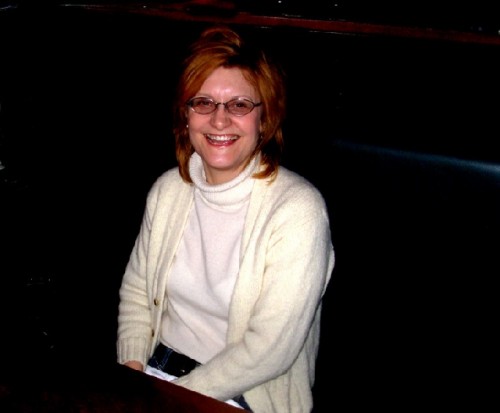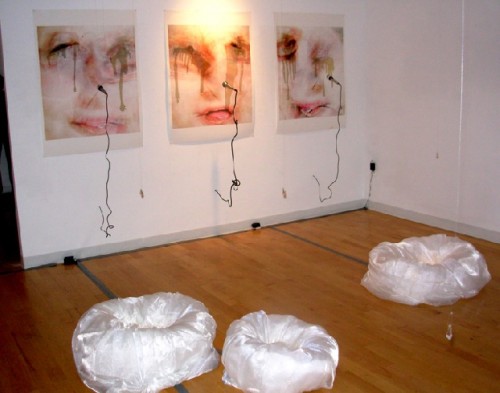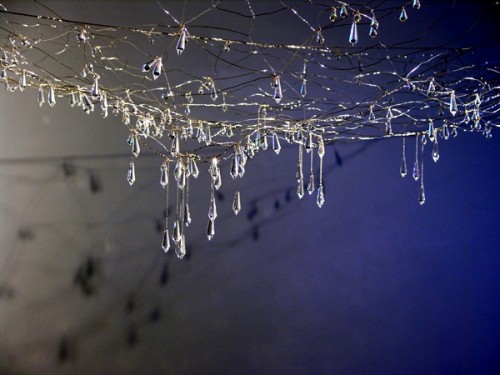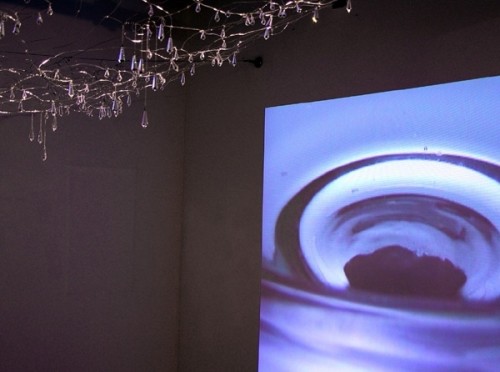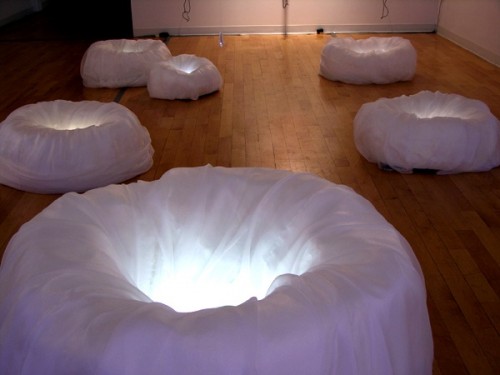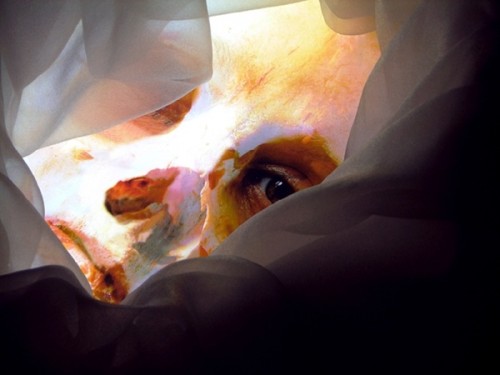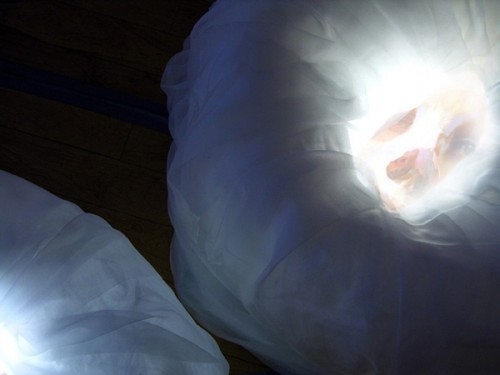Linda Leslie Brown: Beer and Burgers
"Tracks of Your Tears" at Boston's Kingston Gallery
By: Charles Giuliano - Feb 01, 2007
Last year Linda Leslie Brown asked if I would visit a two person show, with video artist Bebe Beard, at
It was a relief to settle down and actually experience the work and engage in a dialogue about it. This was precisely the kind of one to one interchange that is all too rare with colleagues whom we see day in and day out for decades. "The women come and go talking of Michelangelo," Eliot. A life time can pass in which we measure out our lives in tea spoons sweetening the bitter taste of daily life as well as the occasional ground swells of the horrific and tragic. Apparently, Brown had been through a heavy slog of that, and as a part of the Buddhist process, had opted to look death in the face by making a series of self portraits layered over with skeletal elements. These Photoshop derived images were then embedded into an installation by forming light box pools or wells, circles surround with translucent white gauze, that we look down into. These act as signifiers of the ersatz wishing wells of life, transition, loss and memory. How to be a part of and embrace life to the full and yet be capable of tossing off the dearest thing we own as if it were the merest trifle.
Which, of course, is a mouthful. Yesterday, I invited her to join me after school for a Beer and Burger to further the dialogue and recap the experience of a show just taken down 'Tracks of Your Tears" at the artist's cooperative Kingston Gallery which she joined last year. "My beer drinking days are long over," she said with a laugh ordering a diet Coke and a fried burrito, while I stuck to tradition with a Sam and burger, rare. Mostly I wanted to follow up on what started with the Wentworth show. Through the years I have always respected the commitment and experimental nature of the work. There are times when I have really enjoyed it and other times when it was out of synch. Several years ago there was a particularly stunning, lyrical and poetic/ romantic show. The series of Iris prints with poured gel, sprinkled sugar and other elements was simply stunning. I anticipated more of the same. But a single work in the next group show was everything counter to that. All the reasons why I so enjoyed the first work was precisely what disturbed me about that next phase.
There is always that difficult decision about whether to write about such an experience or to avoid the conflict of running into a colleague and experiencing their displeasure. It is a part of the territory that goes with living in a relatively small arts community and the prospect of critic and artist at odds over the work. But the other part of that decision process is that to avoid making critical comments, and only seeking out positive experiences to write about, avoids a greater responsibility of taking the work of peers seriously and going on record with a substantial critical dialogue. To play the double standard risks devolving into the provincial.
Rather bravely, I brought up that review but she wasn't anxious to discuss it. At the time she made an oblique remark about going through hard times. Which also appears to be true about the work of the past year and a half but the difference is that she has taken the issues head on with insight, clarity and guts. Perhaps I expected some closure on the how and why of that earlier review and the work that spawned it. Instead Linda offered a far too familiar comment that part of the problem is that there is so little serious critical writing that when the only reviews that surface are negative it is all the more hurtful. It is a part of the heavy lifting that comes with the responsibility of being a serious critic in a community used to fluff. That has changed recently now that Ken Johnson is writing for the Globe and he seems to have a take no prisoners point of view. It will be interesting to see how long that lasts and what impact that will have.
I asked Linda how long we had known each other? She started teaching drawing at
Today, Brown is a tenured professor and chairs the Foundation Program. Like all of us from the old days she is very grateful to have a good job and security that allows her to put enormous time and resources into creating work that generally does not sell and receives too little critical attention. She described the whole process of selling work and commercial galleries as something of a mystery. Like a lot of us who have been at it for more than a couple of decades the real motive and reward is being able to make the work. Just what sustains us past the cut off point of realizing that we will never be art stars? This is precisely what I most respect about serious and dedicated artists. That ability to keep going against all odds. Toward that end, I asked how she felt about joining a cooperative gallery which entails monthly dues, a monthly meeting, and a day each month of sitting during regular hours? She replied that she went back and forth about it but eventually concluded that there were more compelling reasons to join than not and that several of the members were artists whom she knew and respected.
When NESAD merged with
Just how did she move from
"I was doing clay and painting," she recalls. "We began to realize in the 80s that it was not necessary to have a single style or look. It was a discovery of my generation. I was never a part of a commercial scene so it was never necessary to keep doing the same thing. I sold some but never worked hard at that." While the work has constantly changed and evolved to the point that there is no singular look or style she maintains that "There are always threads that run through the work particularly the interest and use of materials and my approach to combining things."
In the 25 plus years that I have known her Linda has consistently shown the work primarily in alternative spaces. What has sustained that is a profession as a teacher. "I am very grateful to be a teacher," she said. "For better or worse it has kept me in
This made me ask if she had regrets? "Of course," she replied. "But you work on it. Everyone wonders 'what if.' I regret being unkind to other people and I wish I could do more traveling." And of course we all want our work to be better known and appreciated. I asked if the recent
The work strongly addresses issues of loss and death. I asked to what extent she was willing to discuss what had motivated that? She made it clear that she was not going to go into details of specific stories but did make off the record comments about issues of personal loss and the tragic death of peers. "We live in an environment of the contemplation of loss and mourning," she explained. "It comes from being aware that loss is an epidemic part of the human condition. When it happens to you personally it is devastating. In our culture there is not a lot of space for that experience. We are all supposed to be happy. I am a Buddhist and for us there are Four Noble Truths. Two of which are Suffering and Impermanence. Everyone is in transition and we experience pain pretty much all the time."
Referring to the images in the show and the self portraits that through Photoshop have been layered with skeletons I asked if they are her "Pictures of Dorian Grey?" She laughed and responded that she jokes about that. I asked "Do you see yourself as dead?" And was surprised when she answered "yes." She elaborated that there is a Buddhist tradition in
So where do we go from here? After death arguably there is resurrection. Out of the death rituals one is reborn. The

